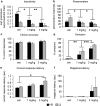Dissociable control of impulsivity in rats by dopamine d2/3 receptors in the core and shell subregions of the nucleus accumbens
- PMID: 19847161
- PMCID: PMC3055378
- DOI: 10.1038/npp.2009.162
Dissociable control of impulsivity in rats by dopamine d2/3 receptors in the core and shell subregions of the nucleus accumbens
Abstract
Previous research has identified the nucleus accumbens (NAcb) as an important brain region underlying inter-individual variation in impulsive behavior. Such variation has been linked to decreased dopamine (DA) D2/3 receptor availability in the ventral striatum of rats exhibiting spontaneously high levels of impulsivity on a 5-choice serial reaction time (5-CSRT) test of sustained visual attention. This study investigated the involvement of DA D2/3 receptors in the NAcb core (NAcbC) and the NAcb shell (NAcbS) in impulsivity. We investigated the effects of a DA D2/3 receptor antagonist (nafadotride) and a DA D2/3 partial agonist (aripiprazole) infused directly into either the NAcbC or NAcbS of rats selected for high (HI) and low (LI) impulsivity on the 5-CSRT task. Nafadotride increased significantly the level of impulsivity when infused into the NAcbS, but decreased impulsivity when infused into the NAcbC of HI rats. By contrast, intra-NAcb microinfusions of aripiprazole did not affect impulsivity. Systemic administration of nafadotride had no effect on impulsive behavior but increased the number of omissions and correct response latencies, whereas systemic injections of aripiprazole decreased impulsive and perseverative behavior, and increased the number of omissions and correct response latencies. These findings indicate an opponent modulation of impulsive behavior by DA D2/3 receptors in the NAcbS and NAcbC. Such divergent roles may have relevance for the etiology and treatment of clinical disorders of behavioral control, including attention-deficit hyperactivity disorder and drug addiction.
Figures






References
-
- Bari A, Dalley JW, Robbins TW. The application of the 5-choice serial reaction time task for the assessment of visual attentional processes and impulse control in rats. Nat Protoc. 2008;3:759–767. - PubMed
-
- Barik A, de Beaurepaire R. Dopamine D3 modulation of locomotor activity and sleep in the nucleus accumbens and in lobules 9 and 10 of the cerebellum in the rat. Prog Neuropsychopharmacol Biol Psychiatry. 2005;29:718–726. - PubMed
-
- Belin D, Everitt BJ. Cocaine seeking habits depend upon dopamine-dependent serial connectivity linking the ventral with the dorsal striatum. Neuron. 2008;57:432–441. - PubMed
Publication types
MeSH terms
Substances
Grants and funding
LinkOut - more resources
Full Text Sources

